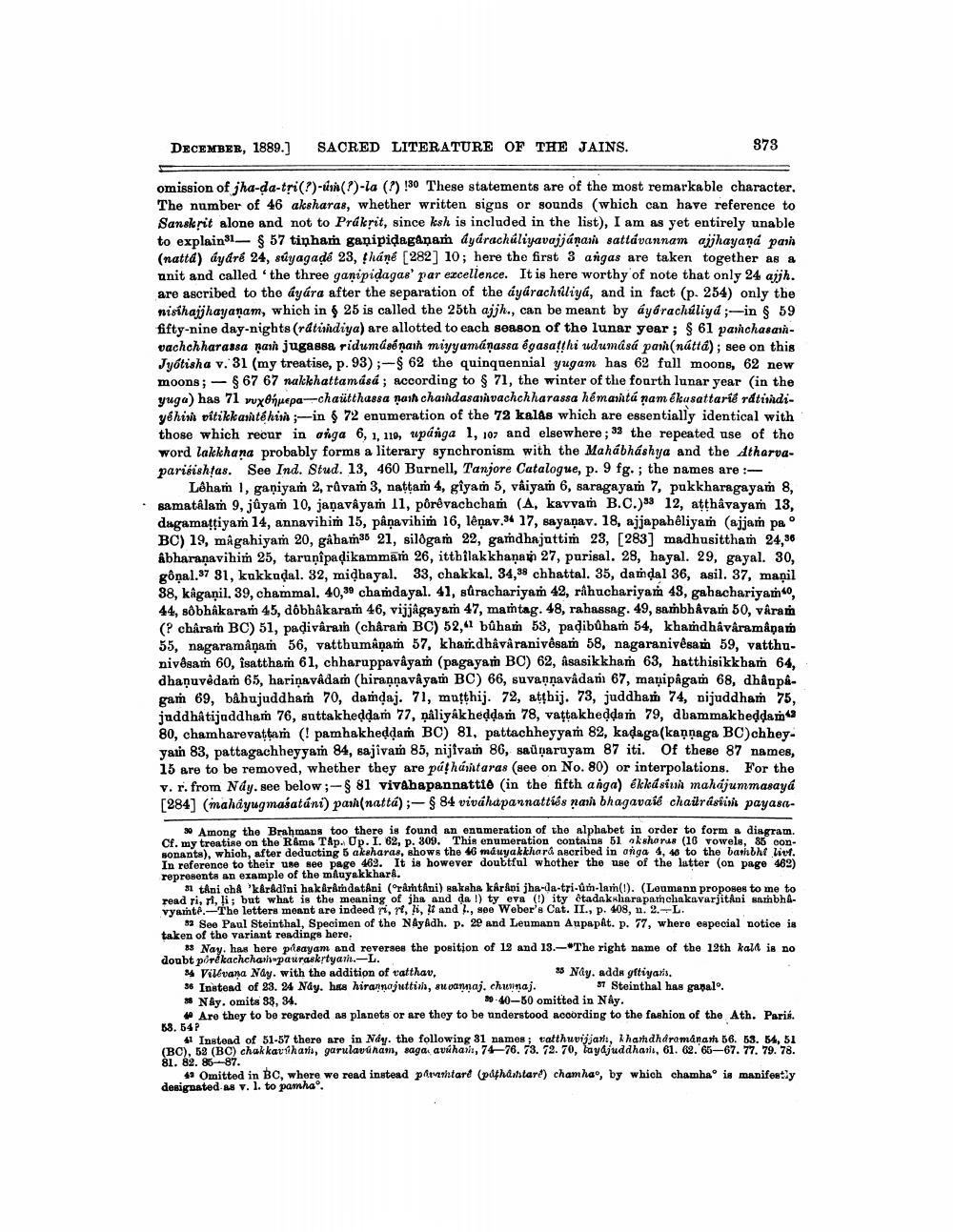________________
DECEMBER, 1889.] SACRED LITERATURE OF THE JAINS.
omission of jha-da-tri (?)-um(?)-la (?) 130 These statements are of the most remarkable character. The number of 46 aksharas, whether written signs or sounds (which can have reference to Sanskrit alone and not to Prákrit, since ksh is included in the list), I am as yet entirely unable to explain31 § 57 tinham ganipidaganam áyárachúliyavajjánam sattávannam ajjhayaná pai (natta) áyáré 24, súyagadé 23, tháné [282] 10; here the first 3 angas are taken together as a unit and called 'the three ganipiḍagas' par excellence. It is here worthy of note that only 24 ajjh. are ascribed to the áyára after the separation of the áyárachiliya, and in fact (p. 254) only the nisthajjhayanam, which in § 25 is called the 25th ajjh., can be meant by úyárachuliya;-in § 59 fifty-nine day-nights (rátindiya) are allotted to each season of the lunar year; § 61 panchasainvachchharassa nam jugassa ridumáséṇash miyyamáṇassa égasaṭṭhi udumásá paṁ(náttá); see on this Jyotisha v. 31 (my treatise, p. 93);-§ 62 the quinquennial yugam has 62 full moons, 62 new moons; § 67 67 nakkhattamásá; according to § 71, the winter of the fourth lunar year (in the yuga) has 71 vuxenpepa-chaütthassa nash chanhdasamvachchharassa hémantá nam ékasattarié ratimdiyehim vitikkamte him;-in § 72 enumeration of the 72 kalas which are essentially identical with those which recur in aiga 6, 1, 119, upanga 1, 107 and elsewhere; 33 the repeated use of the word lakkhana probably forms a literary synchronism with the Mahábháshya and the Atharvaparisishtas. See Ind. Stud. 13, 460 Burnell, Tanjore Catalogue, p. 9 fg.; the names are:
878
-
Lêham 1, ganiyam 2, râvaṁ 3, naṭṭam 4, gîyam 5, vâiyam 6, saragayaṁ 7, pukkharagayam 8, samatâlam 9, jûyam 10, janavayam 11, pôrêvachcham (A, kavvam B.C.) 12, atthâvayam 13, dagamaṭṭiyam 14, annavihim 15, pânavihim 16, lênav.34 17, sayanav. 18, ajjapahêliyam (ajjam pa° BC) 19, magahiyam 20, gâham35 21, silogam 22, gamdhajuttim 23, [283] madhusittham 24,36 abharaṇavihim 25, tarunîpaḍikammam 26, itthilakkhanam 27, purisal. 28, hayal. 29, gayal. 30, gônal.37 31, kukkudal. 32, midhayal. 33, chakkal. 34,38 chhattal. 35, damdal 36, asil. 37, manil 38, kaganil. 39, chammal. 40,39 chamdayal. 41, sûrachariyam 42, râhuchariyam 43, gahachariyam0, 44, sôbhakaram 45, dôbhakaram 46, vijjagayam 47, maṁtag. 48, rahassag. 49, sambhavam 50, varam (? châram BC) 51, paḍivârain (châram BC) 52,41 bûham 53, padibûham 54, khamdhâvâramâņam 55, nagaramanam 56, vatthumanam 57, kham.dhâvâranivêsam 58, nagaranivêsam 59, vatthunivêsam 60, îsattham 61, chharuppavâyam (pagayam BC) 62, âsasikkham 63, hatthisikkham 64, dhanuvedam 65, hariņavâdam (hiranṇavâyam BC) 66, suvannavâdam 67, manipâgam 68, dhâupâgam 69, bâhujuddham 70, damḍaj. 71, mutthij. 72, atthij. 73, juddham 74, nijuddham 75, juddhatijuddham 76, suttakhedḍam 77, nâliyakheḍdam 78, vaṭṭakhedḍam 79, dhammakheddam12 80, chamharevattam (pamhakheḍḍam BC) 81, pattachheyyam 82, kadaga (kannaga BC) chheyyain 83, pattagachheyyam 84, sajivaṁ 85, nijfvam 86, saunaruyam 87 iti. Of these 87 names, 15 are to be removed, whether they are puthamtaras (see on No. 80) or interpolations. For the v. r. from Náy. see below;-§ 81 vivahapannattie (in the fifth anga) ékkásíun mahájummasaya [284] (mahayugmasatáni) pam(nattá);—§ 84 vivahapannattiés nam bhagavaté chaurasiim payasa
30 Among the Brahmans too there is found an enumeration of the alphabet in order to form a diagram. Cf. my treatise on the Rama TAp. Up. I. 62, p. 309. This enumeration contains 51 okshoras (16 vowels, 35 consonants), which, after deducting 5 aksharas, shows the 46 máuyakkhará ascribed in onga 4, 40 to the bathbht livt. In reference to their use see page 462. It is however doubtful whether the use of the latter (on page 462) represents an example of the mauyakkhara.
31 tani cha 'kârâdini hakârâmdatâni (râmtâni) saksha kârâni jha-da-tri-ûm-lam(!). (Leumann proposes to me to read ri, ri, li; but what is the meaning of jha and da !) ty eva (!) ity êtadaksharapanchakavarjitâni sambhâvyamte. The letters meant are indeed ri, rt, li, t and ., see Weber's Cat. II., p. 408, n. 2.-L.
32 See Paul Steinthal, Specimen of the Nayadh. p. 29 and Leumann Aupapât. p. 77, where especial notice is taken of the variant readings here.
ss Nay, has here pasayam and reverses the position of 12 and 13.-*The right name of the 12th kall is no doubt porekachchan-pauraskṛtyam.-L.
24 Vilévana Nay. with the addition of vatthav,
35 Nay. adds gitiyans.
36 Instead of 23. 24 Náy. has hirannojuttim, suvannaj, chunnaj. 38 Nay. omits 33, 34.
57 Steinthal has ganal". 50-40-50 omitted in Nây.
Are they to be regarded as planets or are they to be understood according to the fashion of the Ath. Paris. 53. 54P
41 Instead of 51-57 there are in Náy. the following 31 names; tatthuvijjan, khamdháromânam 56. 53. 54, 51 (BC), 52 (BC) chakkavihan, garulavinam, saga avúham, 74-76. 73. 72. 70, tay juddham, 61. 62. 65-67. 77. 79. 78.
81. 82. 85-87.
43 Omitted in BC, where we read instead parantaré (pathântare) chamha, by which chamha is manifestly designated as v. 1. to pamha°.




